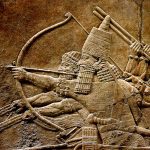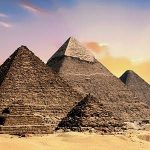Isaiah 11
Read the Text
KJV
King James Version
NRSV
New Revised Standard Version
NIV
New International Version
LEB
Lexham English Bible
HEB
Hebrew Bible
ASV
American Standard Version
NET
New English Translation
Summary
Christ will judge men in goodness and righteousness. In the Millenium, knowledge of the Lord will cover the earth, and Israel will be gathered.
| KJV | JST |
| (15) And the Lord shall utterly destroy the tongue of the Egyptian sea; and with his mighty wind shall he shake his hand over the river, and shall smite it in the seven streams, and make men go over dryshod. | (15) And the Lord shall utterly destroy the tongue of the Egyptian sea; and with his mighty wind he shall shake his hand over the river, and shall smite it in the seven streams, and make men go over dryshod. |
Commentary
Bible Central Commentary
These free resources were developed for use in the free ScripturePlus app. Many of the contributors are professors of religion and ancient scripture at Brigham Young University.
Historical Commentaries
Many of the commentaries below are in the public domain and were authored over 100 years ago. In many cases, they do not reflect the findings of modern scholarship, but they may be helpful for understanding the history of biblical scholarship.
Videos
Watch selected videos on this chapter of the Bible to enhance your study. Note: Not all videos included come from a Latter-day Saint perspective. Inclusion on this list should not imply endorsement for all content.
Overview: Isaiah 1-39
BibleProject
Historical Settings
Time
*All Dates Are Approximate, according to the narrative of the Bible. These dates may reflect literary significance as opposed to the precise dates of history.
See Biblical ChronologyFurther Reading
Matthew L. Bowen, “‘The Messiah Will Set Himself Again’: Jacob’s Use of Isaiah 11:11 in 2 Nephi 6:14 and Jacob 6:2,” Interpreter: A Journal of Latter-day Saint Faith and Scholarship 44 (2021): 287–306.
Matthew L. Bowen, “‘We Are a Remnant of the Seed of Joseph’: Moroni’s Interpretive Use of Joseph’s Coat and the Martial nēs-Imagery of Isaiah 11:11–12,” Interpreter: A Journal of Latter-day Saint Faith and Scholarship 41 (2020): 169–192.
Matthew L. Bowen, “‘They Shall No More Be Confounded’: Moroni’s Wordplay on Joseph in Ether 13:1-13 and Moroni 10:31,” Interpreter: A Journal of Latter-day Saint Faith and Scholarship 30 (2018): 91–104.
Matthew L. Bowen, “‘And the Meek Also Shall Increase’: The Verb YĀSAP in Isaiah 29 and Nephi’s Prophetic Allusions to the Name Joseph in 2 Nephi 25–30,” Interpreter: A Journal of Latter-day Saint Faith and Scholarship 30 (2018): 5–42.
Matthew L. Bowen and Loren Blake Spendlove, “‘Thou Art the Fruit of My Loins’: The Interrelated Symbolism and Meanings of the Names Joseph and Ephraim in Ancient Scripture,” Interpreter: A Journal of Latter-day Saint Faith and Scholarship 28 (2018): 273–298.
Donald W. Parry and Janet L. Garrand Willis, “Notes on Vocabulary in Isaiah 2-11, 13-14, 29, 48-54,” in Isaiah in the Book of Mormon, ed. Donald W. Parry and John W. Welch (Provo, UT: Foundation for Ancient Research and Mormon Studies, 1998), 409–422.
David Rolph Seely, “Nephi’s Use of Isaiah 2-14 in 2 Nephi 12-30,” in Isaiah in the Book of Mormon, ed. Donald W. Parry and John W. Welch (Provo, UT: Foundation for Ancient Research and Mormon Studies, 1998), 151–169.








Complete Commentary on the Whole Bible
Matthew Henry (1706)
Commentary on the Bible
Adam Clarke (1831)
Expository Notes of Dr. Thomas Constable
Thomas Constable
Rashi’s Commentary
Rashi (Shlomo Yitzchaki)
Notes on the Bible
Albert Barnes (1834)
Exposition of the Entire Bible
John Gill (1746–63)
Biblical Commentary on the Old Testament
Carl Friedrich Keil and Franz Delitzsch (1857–78)
Explanatory Notes on the Whole Bible
John Wesley (1754–65)